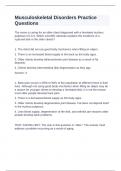Exam (elaborations)
Musculoskeletal Disorders Practice Questions and answers correctly solved
- Course
- Institution
Musculoskeletal Disorders Practice Questions and answers correctly solved The nurse is caring for an older client diagnosed with a herniated nucleus pulposus of L4-5. Which scientific rationale explains the incidence of a ruptured disk in the older clients? 1. The client did not use good body me...
[Show more]



